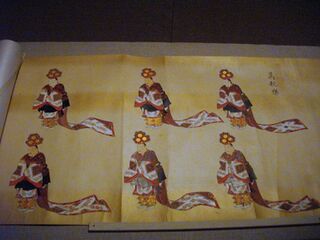Difference between revisions of "Bugaku"
| Line 9: | Line 9: | ||
==Bugaku Dances== | ==Bugaku Dances== | ||
| − | *''Konju'' 胡飲酒 (aka ''Suigoraku'' 酸胡楽, ''Eninraku'' 宴飲楽, ''Inshuraku'' 飲酒楽) | + | *''Konju'' 胡飲酒 (aka ''Suigoraku'' 酸胡楽, ''Eninraku'' 宴飲楽, ''Inshuraku'' 飲酒楽) is a dance based on or inspired by foreigners dancing drunkenly. This dance was performed by members of the [[O family|Ô family]] (多家) since ancient times, but around [[1100]], [[O no Suketada|Ô no Suketada]] was killed by [[Yamamura Masatsura]], and the performance of this dance was suspended for a time. The mask for this dance is a dark red, with large eyes and long black hair.<ref name=mitsukoshi>Masks and gallery labels on display at Mitsukoshi department store, Nihonbashi, Aug 2014.[https://www.flickr.com/photos/toranosuke/15786433330/][https://www.flickr.com/photos/toranosuke/15786333578/sizes/k/]</ref> |
| − | + | *''Nasori'' 納曽利 is a dance associated with the ''gagaku'' piece ''Ryôô'' 陵王. The details are somewhat unclear, but it is generally said to be a dance of two dragons (male and female). When performed by just one dancer, it is called ''Rakuson'' 落蹲. The masks are blue with large white eyes rimmed in red. Large tusks curve upwards out of the upper jaw of the mask, and fangs from the lower jaw, which hangs slackenly from the main portion of the mask, which also features numerous tufts of hair.<ref name=mitsukoshi/> | |
{{stub}} | {{stub}} | ||
Revision as of 02:04, 17 November 2021
- Japanese: 舞楽 (bugaku)
Bugaku is a classical Japanese form of Imperial court dance, closely associated with gagaku court music. It is derived from a combination of Shinto dance and Chinese, Korean, and Southeast Asian influences, and developed into its mature form largely in the 8th-9th centuries.
Like gagaku court music, which is divided into Chinese- and Korean-derived forms (Tôgaku and Komagaku), bugaku is divided into three categories: kuniburi-no-mai (native Japanese dances), Sa-no-mai (dances of the left, derived from those of the Tang Dynasty first introduced in 698), and U-no-mai (dances of the right, derived from those of Korea). The Chinese-style dances typically use red costumes, while the Korean-style ones use green costumes. Performers included both court nobles and hereditary guilds of court entertainers, and bugaku continued through to the modern era.
The Chinese-style dances are typically accompanied by three types of flutes (hichiriki, ryûteki, and shô) and percussion instruments such as the kakko, shôko, and taiko, without string instruments. The Korean-style dances, the shô and ryûteki are replaced by the Korean-style flute (komabue), and the san-no-tsuzumi instead of kakko.
Bugaku Dances
- Konju 胡飲酒 (aka Suigoraku 酸胡楽, Eninraku 宴飲楽, Inshuraku 飲酒楽) is a dance based on or inspired by foreigners dancing drunkenly. This dance was performed by members of the Ô family (多家) since ancient times, but around 1100, Ô no Suketada was killed by Yamamura Masatsura, and the performance of this dance was suspended for a time. The mask for this dance is a dark red, with large eyes and long black hair.[1]
- Nasori 納曽利 is a dance associated with the gagaku piece Ryôô 陵王. The details are somewhat unclear, but it is generally said to be a dance of two dragons (male and female). When performed by just one dancer, it is called Rakuson 落蹲. The masks are blue with large white eyes rimmed in red. Large tusks curve upwards out of the upper jaw of the mask, and fangs from the lower jaw, which hangs slackenly from the main portion of the mask, which also features numerous tufts of hair.[1]
References
- Gallery labels, Tokyo Imperial Palace.[3]
- Gallery label, "Bugaku Scroll," Metropolitan Museum of Art, 57.52.1.[4]
